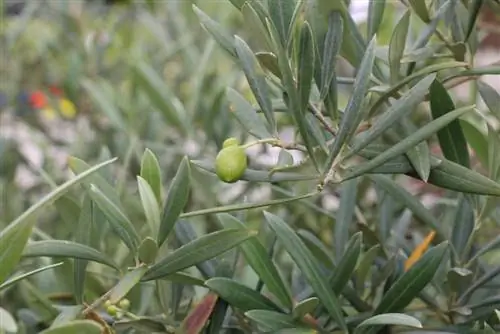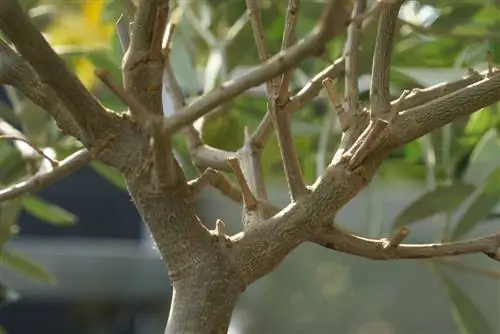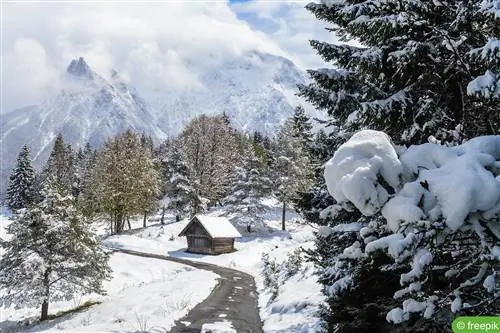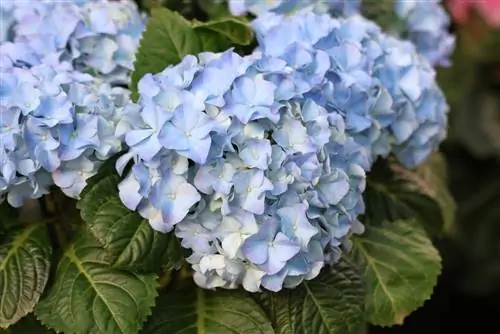- Author admin [email protected].
- Public 2023-12-17 03:39.
- Last modified 2025-01-24 12:45.
With its rustic, gnarled shape and evergreen crown, the olive tree celebrates Mediterranean serenity on balconies and terraces. Since the magical ornamental and fruit tree of the Mediterranean is not part of the natural flora of Central European regions, it is mainly cultivated in pots and buckets. Here it is important to take his special care requirements into account. This green guide will guide you practically through the species-compliant care program. From the ideal location and the balanced water and nutrient balance to pruning and successful overwintering, all aspects are examined in detail.
Excursion into biology simplifies care
Before you dive into the professional care program for an olive tree, we recommend that you familiarize yourself a little with its biology. This makes cultivation in pots and buckets all the easier for you.
The evergreen olive tree is native to the entire Mediterranean region, where it has been cultivated as a crop for many thousands of years. The typical Mediterranean climate prevails in its habitats with average annual temperatures of around 20 degrees Celsius. Its distribution areas are characterized by drought, with annual rainfall hovering around 500 mm. In comparison, the average annual temperature in Germany is around 10 degrees Celsius with precipitation of 800 mm to 1,000 mm. What is characteristic of the olive is that summer heat of 40 degrees Celsius has no negative effects, while temperatures around freezing point have a significant impact on the tree.
Under the influence of the Mediterranean climate, the olive tree has developed the following growth behavior:
- A dense crown of evergreen leaves with silvery hairy underneath
- Terminal and lateral flower panicles with a length of 2 to 4 cm
- Cream-white to yellowish flowers, mostly hermaphrodite, rarely unisexual
- Flowering period between mid/late April to mid/late June
- Single-seeded drupes in autumn
- Branched root system up to 7 m deep
When young, the olive tree has smooth, greenish-gray bark. With age, the distinctive, gnarled, cracked trunk develops, which can take on bizarre shapes. Over the course of its long evolution, the real olive tree has adapted so well that it can live to a very old age in its homeland. One of the oldest specimens is on Crete and is estimated to be more than 4,000 years old.
Location in summer
The olive tree is not suitable for year-round cultivation in living rooms or heated winter gardens. The tree develops its optimum potential in an open-air location so that it can enjoy the unfiltered rays of sunshine and fresh air. If the meteorologists predict in spring that nighttime temperatures will no longer fall below -10 degrees Celsius, your exotic tree will occupy a location with the following conditions:
- Full sunny location with at least 4 to 6 hours of sunshine
- Preferably in front of the south wall of the house or on the south balcony
- Ideally protected from wind and rain
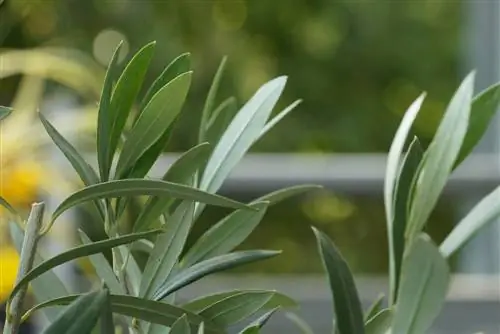
Wet and cold weather in spring can harm your olive even if the temperatures are only around freezing point. In this case, please wait until dry spring weather prevails. On the other hand, there is no reason to worry when summer comes with temperatures of 35 degrees and higher and the heat builds up at midday.
Tip:
Before an olive tree takes its full sun location, it should acclimatize in a partially shaded location for 8 to 10 days. If suddenly exposed to direct sunlight, the evergreen leaves suffer sunburn. The resulting light brown spots spoil the pretty foliage all summer long.
Substrate
In a pot, an olive tree naturally cannot develop its extensive and deep root system. The quality of the substrate is therefore particularly important. In addition to providing nutrients, water and oxygen, the perfect soil offers the roots reliable stability without compaction. Conventional potting soil does not come close to meeting these requirements. Special substrates for olives from specialist retailers have the right composition, but are quite expensive. Alternatively, mix the plant soil yourself, which consists of these components:
- Well-ripened garden compost
- Choice of bark humus from the store
- Loamy garden soil or natural clay
- Coconut or wood fibers
- Garden, algae or dolomite lime
- Expanded clay, lava granules, sand or fine-grained grit
You will look in vain for the ultimate recipe for the perfect mixing ratio. There are numerous recommendations circulating among olive gardeners, from which you will develop your personal recipe over the years. A mix of 35 percent clay soil and compost, 20 percent wood or coconut fibers and 10 percent activated lime and quartz sand is generally accepted.
This composition signals a lime tolerance, which is unusual for Mediterranean plants. In fact, a pH value between 7 and 8 is one of the central criteria for vital growth of your Olea europaea. Unfortunately, it is a common misconception to equate olive and lemon trees in this regard. Therefore, when buying, do not use citrus soil, as it is designed for a pH value between 5.5 and 6.5, which is not good for your olive tree.
Pouring
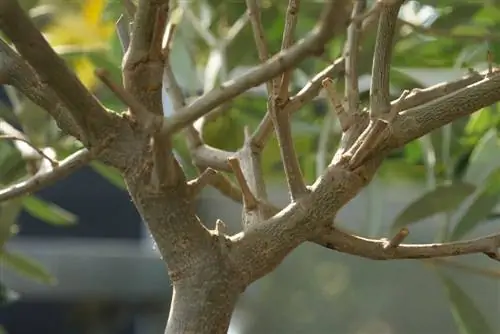
The special demands on care in the pot are reflected in the fact that the water supply differs significantly from planted olive trees. In a warm, sunny location, the moisture in the substrate evaporates quickly. While the natural rainfall in the bed is usually sufficient and the root system, which can be up to 7 m deep, provides compensation via the groundwater, an olive in a pot depends on regular watering. How to do it right:
- The goal is an alternately moist plant soil with an interim drying phase
- Water thoroughly if the substrate surface is dry
- Let the water run out of the spout until the soil at the bottom of the pot is moist
Do not water the olive tree again until the finger test shows that the soil is 1 to 2 cm deep. This procedure ensures that no waterlogging can form, which is life-threatening for every olive tree. Please use normal tap water, but not straight from the tap if it is still ice cold.
Tip:
With a moisture meter you have a valuable tool in your hands for watering your olive tree as needed. If the measuring stick is inserted into the substrate, a scale clearly shows whether the root ball is dry, semi-dry or wet.
Fertilize
As long as an olive tree is growing, blooming and fruiting, it needs additional nutrients in the pot. Since supplies in the substrate are limited, fertilizer application begins 6 weeks after potting or repotting. Its special care requirements require the use of special preparations for Mediterranean plants, such as Compo Mediterranean plant fertilizer, High-Tech Olea olive fertilizer from Green24 or Chrystal fertilizer sticks for Mediterranean plants. Conventional complete fertilizers, such as Blaukorn or Entec, are not recommended for olives. The ideal nutrient intake is as follows:
- Fertilize the olive tree from March to September
- Add a liquid olive fertilizer to the irrigation water once a week
- Alternatively, press fertilizer sticks into the substrate in March, May and July
- Administer a slow-release fertilizer for Mediterranean plants in March and June
From September to February, stop supplying nutrients, as an olive tree hardly uses any energy during this time. To ensure that the nutrient s alts contained in the fertilizer do not burn the roots, please water with clear water before and after administration.
Tip:
In the ecologically maintained Mediterranean garden, you can cover the nutrient needs of your olive tree in the pot with a liquid organic fertilizer. The high-quality Biobest organic earthworm fertilizer is ideal and can be added to the irrigation water every 8 to 10 days from March to September.
Wintering outdoors

Designing the conditions for an olive tree in a pot so that it survives the difficult winter period is a special challenge. This is even more true if overwintering outdoors is an option because the garden is Located within hardiness zone Z8. These include, among others, the wine-growing regions, the Lower Rhine and other regions where the minimum winter temperature is -10 degrees Celsius. How to overcome the hurdle of overwintering in a pot outdoors:
- Place a large wooden box on a plant trolley in front of a house wall or in a wall niche
- Lay a thick layer of bark mulch on the bottom of the box
- Place the pot in the middle and stuff it all around with straw
- Cover the substrate with leaves, straw, sawdust or wood shavings
- Alternatively, fill in bark mulch up to the edge of the bucket and on top of the substrate
- Cover the olive crown with breathable and translucent fleece
The closer the olive tree in the pot is to a house wall, the more it benefits from the waste heat there during the winter. Ideally, the winter spot is also protected from moisture by a canopy. Where the solution with the wooden box cannot be implemented, the pot is given a thick winter coat made of several layers of fleece or foil.
Care during wintering in the garden or on the balcony is limited to moderate watering. Despite the dormant growth period, the evergreen leaves continue to release moisture. Therefore, water on frost-free days to avoid ball dryness.
Wintering behind glass
Where winter is accompanied by severe frost, overwintering requires accommodation behind glass. Of course, this does not mean a well-heated living room, as complete loss of leaves is unavoidable here. Rather, your olive tree wants a bright, frost-free location with temperatures of up to a maximum of 10 degrees Celsius. The bucket is only put away when the mercury falls below -5 degrees Celsius at night. Some time under the influence of winter cold sets the flower induction for the next season in motion and thus promotes a rich olive harvest. How to keep your precious tree he althy and happy through the winter:
- Continue watering moderately without causing waterlogging
- Do not fertilize from October to February
- Air the winter storage room every 2 to 3 days without allowing cold drafts to occur
The shortlist for winter quarters is an unheated winter garden, a bright garage or a cool, light-flooded staircase. If it is unavoidable that temperatures rise above 10 degrees Celsius, a plant lamp or daylight lamp compensates for the increased light requirement. However, if you banish your olive to the dark boiler room, this is by far the most problematic wintering option. The extent to which the resulting leaf shedding will be compensated for next spring and summer cannot be predicted, even by experts.
Cutting
The very slow growth requires systematic pruning. To ensure that your olive tree maintains its well-shaped and densely leafy crown, pruning is not part of the care program every year. Therefore, in April and May, subject your olive to a thorough examination to decide whether pruning is necessary. Only use scissors when the tree is bare from the inside, long shoots are growing out of shape or branches have been damaged by frost. The best time for a shape and maintenance cut is an overcast day shortly before new growth. With this cut you can do it:
- In the first step, thin out the crown by removing dead branches
- Short branches that are too long until just before a bud or a leaf node
- First cut the leading branches and then shorten their side branches a little more
- Cut off the shoots on the trunk below the crown
- Cut back frozen or diseased branches down to he althy wood

Take a few steps back repeatedly to plan the further incision. The leisurely rate of growth will only close any holes created very slowly. Therefore, cut in small stages or, if in doubt, let the scissors rest. Please note that leafless branches are not necessarily dead. Before removing a vital shoot, wait until early summer. Only when no new leaves actually appear do you cut off the dead part.
Repotting
On a lovingly cared for olive tree, the crown and root ball grow in proportion to each other. This means that every 2 to 3 years the pot volume is no longer sufficient for the roots and thus the crown to develop unhindered. Furthermore, after a while the substrate becomes so depleted that even regular fertilization no longer covers the energy requirement. If the pot is too crowded or the first roots are finding their way through the opening in the bottom, repot your olive between February and May. The new pot is so large that there is space for two fingers between the root ball and the pot wall. How to proceed professionally step by step:
- Use a knife to loosen the edges of the root ball from the edge of the pot
- Lay the olive tree on its side, grasp it at the base of the trunk and pull it out
- Shake the root ball vigorously and loosen it with both hands
- Create a 3-5 cm high drainage out of potsherds or grit on the bottom of the pot
- Place an air and water permeable fleece over it
Now measure how high the lower substrate layer needs to be so that the root disc is about 3 cm below the edge of the pot. Fill in the recommended substrate, place the root ball in the middle and fill the cavities. Pressing down the fresh soil in the meantime prevents gaps from forming that would hinder rapid rooting. In the last step, water thoroughly. For the next 8 days, the repotted olive tree will remain in a partially shaded location to regenerate.
Propagate
We recommend the cuttings method for propagating olive trees. This approach is so practical and promising that it is also favored in large olive plantations. At the beginning of the vegetation phase, cut 10 cm long top cuttings from annual shoots, provided that the pruning does not already provide the suitable material in the form of clippings. Proceed as follows.
- Fill a propagation tray with coconut fiber substrate and press down
- Cut each cutting 8 to 10 mm below a leaf at a slight angle
- Defoliate half of the cutting
- Dip the cut site in a rooting powder
- Place two thirds of the cuttings into the soil at a distance of 2 to 3 cm
- Spray cuttings and soil with water
- Place the bowl in a heated indoor greenhouse
A combination of high humidity and temperatures around 30 degrees Celsius is important for rooting olive cuttings. Ventilate the mini greenhouse daily and spray the cuttings with room temperature water when the substrate has dried. Only when fresh shoots appear can the cuttings be cleared out of the mini greenhouse, as normal room temperatures are now sufficient for further growth.
Common diseases
An olive tree is susceptible to eyespot disease, which is caused by the fungal pathogen Spilocaea oleagina. Symptoms of infection are dark spots with a light halo that spread across the entire leaf, causing it to die. Persistently remove every diseased leaf to prevent the fungal spores from spreading further in the early infestation stage. If more than half of the crown is infected, control the disease with a copper-based fungicide, such as Atempo Pilzfrei or Cueva Pilz-frei from Neudorff.
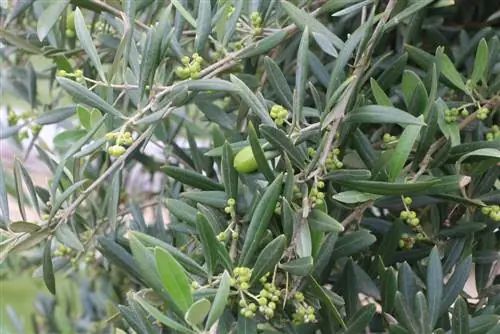
With olive cancer you are dealing with a hardened bacterium that penetrates into the interior of the plant through the smallest wounds in the bark. In addition to brown discoloration, cracks on the bark and dark red lesions, this disease manifests itself through cancerous growths. To date, no effective control agents are available. Diseased plant parts should be cut out and burned. Preventive measures include a rain-protected location, no overhead watering and meticulous disinfection of cutting tools.
Pests
Overwintering that is too warm weakens your olive tree in the pot considerably and attracts all kinds of scale insects. Signs of an infestation include small bumps on the leaves caused by scale insects or white cotton balls caused by mealybugs and mealybugs. Since the pests are after the plant sap, their activity must be stopped. An effective way to combat lice is to wipe the leaves with a soft cloth soaked in alcohol. Dusting with diatomaceous earth dissolves the shell of scale insects and dries out the insects underneath.
Conclusion
An olive tree in a pot and bucket will only live up to its reputation as a Mediterranean symbol of longevity if the care takes its special requirements into account. A sunny, warm location in summer and a bright, cool location in winter set the course. A needs-based water and nutrient balance, tailored to the season, rounds off the annual care program. At intervals of 2 to 3 years, shape and maintenance pruning as well as moving to a larger pot are on the agenda in spring. In all care measures, there is always the underlying fact that a real olive tree differs in many respects in its requirements from other Mediterranean plants, such as lemons or oranges. If the requirements of these instructions are followed, diseases and pests have a low chance of becoming infested.

